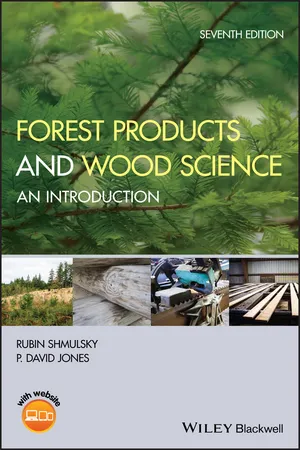
- English
- ePUB (mobile friendly)
- Available on iOS & Android
About this book
The updated seventh edition of the classic text on wood science and forestry
The seventh edition of Forest Products and Wood Science: An Introduction offers a fully revised and updated review of the forest products industry. This classic text contains a comprehensive review of the subject and presents a thorough understanding of the anatomical and physical nature of wood. The authors emphasize its use as an industrial raw material.
Forest Products and Wood Science provides thorough coverage of all aspects of wood science and industry, ranging from tree growth and wood anatomy to a variety of economically important wood products, along with their applications and performance. The text explores global raw materials, the increasing use of wood as a source of energy and chemicals and environmental implications of the use of wood. This edition features new material on structural composites, non-structural composites, durability and protection, pulp and paper, energy and chemicals, and global raw materials. This seventh edition of the classic work:
- Contains new information on a variety of topics including: structural composites, non-structural composites, durability and protection, pulp and paper, energy and chemicals and global raw materials
- Includes a fully revised text that meets the changing needs of the forestry, engineering, and wood science academics and professionals
- Presents material written by authors with broad experience in both the private and academic sectors
Written for undergraduate students in forestry, natural resources, engineering, and wood science, as well as forest industry personnel, engineers, wood-based manufacturing and using professionals, the seventh edition of Forest Products and Wood Science updates the classic text that has become an indispensable resource.
Frequently asked questions
- Essential is ideal for learners and professionals who enjoy exploring a wide range of subjects. Access the Essential Library with 800,000+ trusted titles and best-sellers across business, personal growth, and the humanities. Includes unlimited reading time and Standard Read Aloud voice.
- Complete: Perfect for advanced learners and researchers needing full, unrestricted access. Unlock 1.4M+ books across hundreds of subjects, including academic and specialized titles. The Complete Plan also includes advanced features like Premium Read Aloud and Research Assistant.
Please note we cannot support devices running on iOS 13 and Android 7 or earlier. Learn more about using the app.
Information
CHAPTER 1
Tree Growth and Production of Woody Tissue
Classification of Woody Plants
| Divisions: | Thallophytes | Bryophytes | Pteridophytes | Spermatophytes (seed plants) |
| Algae | Mosses | Ferns | ||
| Fungi | Liverworts | Horsetails | ||
| Rushes | ||||
| Subdivisions: | Gymnosperms | Angiosperms | ||
| (naked seed) | (seed in fruit) | |||
| Orders: | Cycadales | Ginkgoales | Gnetales | Coniferales |
| Classes: | Monocots | Dicots | Yucca | |
| (palm‐like) | (rare) | |||
| Families: | Cupressaceae | Taxaceae | Pinaceae | Taxodiaceae |
| Cedar | Yew | Fir | Redwood | |
| Juniper | Larch | Hemlock | Baldcypress | |
| Cypress | Pine | |||
| Spruce |
Table of contents
- TABLE OF CONTENTS
- PREFACE
- AUTHORS BIOGRAPHICAL SKETCHES
- INTRODUCTION
- ABOUT THE COMPANION WEBSITE
- CHAPTER 1: Tree Growth and Production of Woody Tissue
- CHAPTER 2: Macroscopic Character of Wood
- CHAPTER 3: Composition and Structure of Wood Cells
- CHAPTER 4: Softwood Structure
- CHAPTER 5: Hardwood Structure
- CHAPTER 6: Juvenile Wood, Reaction Wood, and Wood of Branches
- CHAPTER 7: Wood and Water
- CHAPTER 8: Density and Specific Gravity
- CHAPTER 9: Strength and Mechanics
- CHAPTER 10: Durability and Protection
- CHAPTER 11: Silvicultural Practices and Wood Quality
- CHAPTER 12: Lumber
- CHAPTER 13: Structural Composites
- CHAPTER 14: Nonstructural Composites
- CHAPTER 15: Pulp and Paper
- CHAPTER 16: Energy and Chemical Products
- CHAPTER 17: Global Raw Materials
- INDEX
- END USER LICENSE AGREEMENT